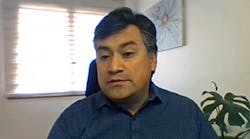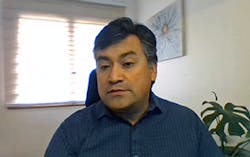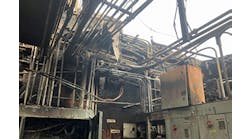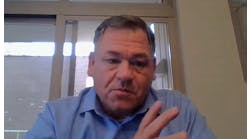Mining practices evolve for COVID and beyond
“The concept of connected maintenance requires connection to remote management and real-time data management. And cybersecurity has a long way to go.” BHP’s Daniel Riquelme was among several mining professionals who discussed the state of digital transformation in the mining industry.
The Mining Industry Forum this week at the Automation Fair at Home focused a panel of industry and mining experts on technologies and trends driving changes, particularly in response to the ongoing global COVID-19 pandemic. Moderated by Michael Klein, director, marketing strategy at Rockwell Automation, the panelists were Carl Weatherell, executive director and CEO, Canada Mining Innovation Council (CMIC); Phil Nelson, principal engineer, XPS Expert Process Solutions; Daniel Riquelme, manager, control systems, BHP; and John Woods, global director, Kalypso.
Asked about their visions of the post-COVID business environment, Riquelme said the pandemic has touched every part of the industry. “It’s amazing how fast we’ve moved, but it’s still exposed our fragility,” Raquelme said. “Now mining is in a recovery phase, and we have the opportunity to return better and stronger, more sustainable, using more renewable energy and better water management to improve living standards.” He also mentioned the new role of remote operations, “a new environment for service providers,” he said. “There’s no going back.”
COVID-19 has accelerated opportunities, and given way to new ones that wouldn’t have been considered in the past, including “big gains in remote work,” said Nelson. “We’re a globally diverse organization with more remote collaboration, more opportunities but we need new protocols to do it safely, and to do the highest quality work.” Automation is seen as a major cost driver.
“As an innovation organization, we see miners and suppliers reexamining their businesses to create buffers,” said Weatherell. Innovation and its effect on the bottom line is far more important and more critical now. Miners are looking hard at accelerating new technologies such as continuous, mechanical cutting and core sorting. “We need to build new and different relationships between companies and suppliers—coopetition,” he added. “We can’t solve these issues ourselves.”
Mining’s connection to the environment—and people’s perception of that relationship—is also critically important. “We need to show our custodial expertise as responsible stewards of the earth’s resources,” Woods said.
Digital transformation projects
In mining as in other industries, digital transformation is a hot topic. “I have two example projects from mining,” said Nelson. “I tell one of our site directors he can say he’s been doing machine learning since 2005, when they started monitoring machines to determine when to have shutdowns.”
The second is a model-predictive control application. “It’s an old application with a new spin,” Nelson said. “We can embed it in the control system instead of running it standalone.” The application “talks” to technicians in their own terms, so it has become simple, widespread and available.
It’s good to keep it simple to encourage adoption. “Digital transformation is about how work is done, and how you use tools to enable work,” said Woods. “At the coal face, how are you helping people do the job better and safer, and adding value?”
For example, Kalypso put an IoT platform in for better short-interval control management at an exploratory drilling business. “We focused on two things at the outset: making sure there’s a clear articulation of the business value—in this case, how are we drilling more productively by applying what we’re doing?” Woods said. The second was to use the IoT platform for continuous improvement (CI)—for root-cause analysis and data extraction. “We worked very closely with the CI team to enable them to use the information to run lean six sigma, making it very real and getting change to happen,” Woods said.
Still need people in the field?
There’s a great opportunity to allow technicians to be more efficient and to standardize work with digitalization by doing training and asset management with real-time data, to be ready to react. It raises the need to connect and aggregate information, with good data sensors across the plant, remote support, augmented reality and smart wearables.
“The concept of connected maintenance requires connection to remote management and real-time data management,” said Riquelme. “And cybersecurity has a long way to go.”
Nelson said they still see the need for more instrumentation, more communication and better tools for analysis “so we can get to things and fix them just before they need it,” he said. “That way, we can get the confidence to not do the other things that don’t need to be done.”
Information tools can make technicians more efficient in other ways, as well. “I saw a tool that works like Google Maps in the plant to direct the technician to the location of an instrument, and let him know if he’s going to need a lift,” Nelson added.
Integration and the supply chain
Some would say the supply chain is holistically integrated. “I say no,” said Weatherell, “but the building blocks are there. In the future, simulation of the business, taking scenarios into account and seeing what will happen, will come. Do we have the data? Some. Do we share the data? Some. Do we understand and use the data we have? Some.
“If we want to get there, it’s not a solo act. Mining companies and suppliers should collaborate more, and draw in other industries—aerospace, construction with its bills of materials (BIMs). Gaming industry modeling and simulation engines are very powerful.”
Industry has digital twins and digital threads from planning through support. “Can we use that to simulate?” asked Woods. “The technology is there in components, but it’s not integrated yet.”
For planning, you have the data, “But what do you do with it?” Woods asked. “It takes judgment, anticipating changes in human behavior and tastes. More vodka, or more gin? Make an entrepreneurial decision, and bet on it.”
Weatherell added, “Innovation happens at the speed of trust, not the speed of tech.”
The editors of Control, Control Design and Smart Industry are providing coverage of Automation Fair At Home, bringing you breaking news, innovations and insights from the virtual event. Once Automation Fair At Home is over, the editors will put together an event report featuring the top news. Pre-order your copy today.






